August 2017
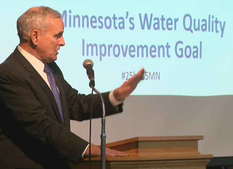 About 300 people, double what was expected, showed up for the water quality town hall meeting Monday in Rochester. It was the first of 10 town hall meetings as part of Gov. Mark Dayton's "25 by 25" clean water initiative, which aims to improve water quality in Minnesota by 25 percent by 2025. (Photo: KAAL-TV). They offer Minnesotans an opportunity to discuss the water quality challenges facing their communities and our state, learn from experts, and engage with policymakers. The meetings build on the momentum from Gov. Dayton’s “25 by 25” Water Quality goal proposal, announced earlier this year.
Achieving a 25 percent improvement in water quality statewide would require Minnesota to take aggressive, yet achievable action. It also would help Minnesota meet existing commitments to reduce phosphorus 12 percent by 2025 and nitrogen 45 percent by 2040 in the Mississippi River. Each town hall meeting will run from 6:30-8:30 p.m. with registration beginning at 6 p.m. No advance registration is necessary. A detailed list of dates and locations is available online.
- July 31: Rochester Community and Technical College.
- Aug. 16 : Minnesota State University, Mankato.
- Aug. 17:Southwest Minnesota State University, Marshall.
- Sept. 5: University of Minnesota – Crookston.
- Sept. 6: St Cloud Community and Technical College.
- Sept. 12: Grand Ely Lodge, Ely.
- Sept. 13: Bemidji State University.
- Sept. 26: Minneapolis Urban League.
- Oct. 4: Diamondhead Education, Burnsville.
- Oct. 5: Stillwater High School, Stillwater.
Back to top
|
 Minnesota farmers and land owners affected by the state's buffer law can now find the information they need on a new, easy-to-use website. This
one-stop site provides links and resources to help answer questions
about water quality buffers, access financial and technical assistance
to install buffers, and more.
Gov. Dayton worked with lawmakers to give additional flexibility
to farmers and landowners who require financial and technical assistance to
comply with the clean water buffer standards and are making good faith efforts
with their local Soil and Water Conservation Districts (SWCDs). November 2017 is the deadline to install water quality buffers on lands adjacent to public waters, and November 2018 for lands adjacent to public ditches.
Landowners who cannot meet
the first deadline may commit to a compliance plan with their local SWCD by
Nov. 1, 2017 and then have until July 1, 2018 to implement their buffer or
alternative practice. These waivers will offer landowners up to eight months to
work with their local SWCD to implement buffers and alternative practices. The
law on alternative practices now includes the common practices adopted and
published by the Board of Water Soil Resources, or practices approved by the
local SWCD consistent with the Field Office Technical Guide.
The Board of Water and Soil Resources reports that statewide 89% of parcels adjacent to Minnesota waters meet preliminary compliance with the law. SWCDs are reporting encouraging progress in their work with landowners around the state. View the buffer maps for a visual representation of the buffer law.
Back to top
|
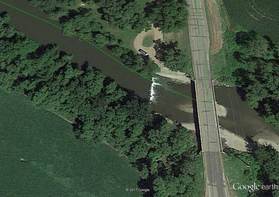 Three more dams in the Minnesota River basin are slated for removal in the ongoing effort to restore the river and tributaries to more natural flows. DNR received a $870,000 LSOHC grant passed to Redwood County for the removal of three low-head dams on the Cottonwood River: Sanborn Park, four feet high; Sanborn Golf Course, three feet high; and Kuhar Park, Lamberton, five feet high. The grant goes to June 1, 2021, and construction may start in late 2018 or early 2019. Photo: Google Earth image of dam at Kuhar Park north of Lamberton.
The primary purpose
is to improve the ecology of the river system and restore fish and aquatic species upstream. Of the 66 native fish
species found in the Cottonwood River watershed, 32 are absent upstream of
these dams. More than 200 miles of the river will be reconnected. All three dams are deteriorating and are a
safety risk factor. In place of the dams, rock arch rapids or riffle structures will provide grade
control, bank stability, redirection of flows and stream habitat
improvement.
The dams were installed many years ago to create pools for recreation and ice-cutting. They will add to the growing list of removed dams, including the Minnesota Falls dam, Chippewa River, Lac qui Parle River, and High Island Creek. The May-June Minnesota Conservation Volunteer magazine features an article describing the history of dams and the benefits of restoring natural flows: River Revivals, by Luther Aadland. According to American Rivers, nationwide, 1384 dams have been removed from 1912 through 2016.
Back to top
|
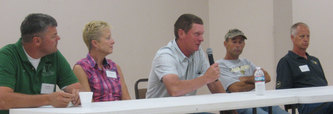 For crop producers interested in trying cover crops, some of the best advice comes from the handful already doing it. Along with all the technical stuff, they'll say 'stay out of the coffees shops' and 'get past the skepticism of neighbors'.
More than 75 farmers and agency staff turned out June 29 in Renville for a 'benefits of cover crops' meeting hosted by the Hawk Creek Watershed Project and Renville County SWCD. A panel of area farmers successfully using cover crops described their experiences and challenges. "After 40 years of conventional farming, this is upside down," said one panelist. "It's a huge learning curve" and start small. Photo, L-R: Brian Pfarr, Dawn and Grant Breitkreutz (with microphone), Brad Nere, and Brian Ryberg. Also participating: Kyle VanOverbeke and Joel Timm.
Survey feedback: 'We learned a lot'
"We had a lot of positive
feedback with over 60% of post-meeting survey respondents saying they learned a
great deal," says Heidi Rauenhorst, Hawk Creek coordinator. "They liked the visual
demonstrations (presented by Holly Hatlewick, Renville SWCD administrator) of the slake test and rainfall simulator to see for themselves
the difference in healthy soil and unhealthy soil." Comments about what they learned included:
- Ripple effects of
increased soil health,
- Benefits of strip/no-till versus conventional tillage,
- Different options for cover crop species,
- Equipment modifications
used to interseed cover crops,
- Incorporating livestock into a cover cropping
operation had huge benefits,
- Seeing soil structure and organic matter
differences in healthy and unhealthy soils,
- Resources available to help with cover crops (seed sales, SWCD, HCWP, other farmers),
- Effects of herbicides and timing on cover crops,
- Differences in water
infiltration rates of healthy versus unhealthy soils,
For more information see the Dept. of Agriculture cover crop webpage.
Back to top
|
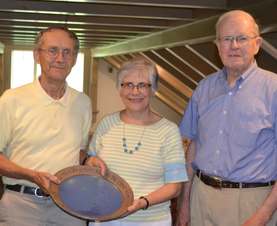 Darby and Geri Nelson of Champlin received the annual RiverKeeper award from CURE - Clean Up the River Environment of Montevideo. CURE is celebrating its 25th year as a grassroots nonprofit in rural
Minnesota, and with Gov. Dayton’s focus on clean water initiatives
throughout the state, Darby and Geri were chosen as the
2016 RiverKeepers.
"Key attributes of the RiverKeeper recipients are individuals whose
lives exemplify CURE’s mission to 'protect and restore resilient rural
landscapes by harnessing the power of citizens who care about them', and it is
clear that the Nelsons have spent decades as stewards for water protection." Photo l-r: Darby and Geri with a Tokheim Stoneware commemorative platter, and David Minge, former Congressman from Montevideo, and current Friends of the Minnesota Valley board member.
Dedicated to education, conservation advocacy
The Nelsons have dedicated their lives to
education, conservation, and advocacy in the name of the environment;
particularly clean water. Darby, a freelance writer, received his Ph. D.
in aquatic ecology from the University of Minnesota. He taught biology and environmental science at Anoka-Ramsey Community College for
35 years and served three terms in the Minnesota state legislature. He worked diligently on environmental
initiatives and was influential in passing a bill that started the Minnesota
Board of Soil and Water Resources. In
2011, Michigan State Press published Darby’s first book, "For the Love of Lakes," which tells the story of his love of lakes
and his observations of their deterioration.
Geri, a scientist and educator herself, is a member of the U of
M’s first graduating class of the College of Biological Sciences. She taught physical science in the
Anoka-Hennepin School District for 25 years, and served as director of the Minnesota Academy of Science State Science Fair, and
helped develop the state’s science framework for K-12 education.
Back to top
|
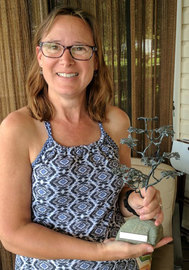 Linda Dahl was recognized for her work leading the Southeast Minnesota Water Resources Board with the first ever S.P. Kingston Award. Dahl came to the board in 2009 with backgrounds in natural resources and agriculture. She is noted for long-term projects she helped manage, including the small feedlot program, the Southeast Minnesota Wastewater Initiative and the Volunteer Nitrate Monitoring Network.
The award honors S.P. Kingston, one of the most influential water resources professionals in the region. An engineer with the Dept. of Health in the 1940s, Kingston wrote a paper, "Contamination of water supplies in limestone foundation."
The SEMWRB is a ten-county Joint Powers Board to help sustain the quality of life by improving and protecting the water resources through the coordination of local water planning efforts. Bridgette Timm of Olmsted County is taking over the executive director post. The counties include: Rice, Goodhue, Wabasha, Steele, Dodge, Olmsted, Winona, Mower, Fillmore, and Houston.
Dahl earned a degree in
biology from Winona State University, and worked for Minnesota Conservation Corps, DNR, USDA-AmeriCorps, and Whitewater Watershed Project. She converted 14 acres of her Winona County farm to native
prairie habitat and planted thousands of trees for woodland improvement on the
forested slopes. While she is making a
career change and planning to spend more time with her five-year-old daughter, she will continue to promote native plantings in urban and
rural areas of Southeast Minnesota.
Back to top
|
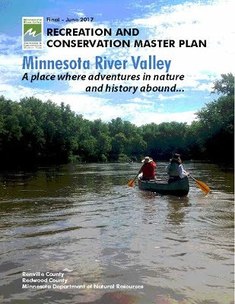 The completed Minnesota River Valley Recreation and Conservation Master Plan and Public Comment Summary Report can now be viewed on the project website. Next steps include official review, approval and adoption by individual county park boards and county commissioners and Dept. of Natural Resources.
The
plan, developed by the DNR in collaboration with
Redwood and Renville counties, will leverage natural, recreational, cultural,
historical and agricultural assets located within two miles either side of the
Minnesota River in the two counties. If you have additional comments, questions or would like to stay involved in future planning, contact any of the following: Scott Wold, Redwood County Environmental Office, Scott_W@co.redwood.mn.us, 507-637-1159; Scott Refsland, Renville County Environmental Office, scottr@renvillecountymn.com, 320-523-3664; Catherine Fouchi, DNR Region 4, Cathi.fouchi@state.mn.us, 507-359-6034.
Back to top
|
 Fisher leaves MSU-WRC for DNR fisheries
Dr. Shannon Fisher (photo, right) has resigned from Minnesota State
University-Mankato, returning to the Dept. of Natural Resources in fisheries management. For information about the MSU Water Resources Center, contact Diane Wiley at
507-389-5492.
SE Minnesota Water Resources Board gets new director
Bridgett Timm of Olmsted County is the new director for the Southeast Minnesota Water Resources Board. She replaces Linda Dahl who has retired. It is a ten-county joint powers board dedicated to the protection of the water resources in Southeast Minnesota in the counties of Rice, Goodhue, Wabasha, Steele, Dodge, Olmsted, Winona, Mower, Fillmore, and Houston.
Science of healthy waters-ditching dilemma workshop Sept. 11-13
The Dept. of Natural Resources is offering a River Health and Restoration workshop Sept. 11-13 in Blue Earth. This
workshop unpacks the science and policy of ditching in terms of: 1) effects on
hydrology, geomorphology, water quality, and aquatic habitat, 2) societal and
ecological implications of these practices, and 3) alternative design concepts
and approaches that work towards accomplishing sustainable agricultural goals
while improving water quality and restoring channel stability and ecological
health. For more information contact Amy Childers, 218-739-7576 ext. 233, amy.r.childers@state.mn.us.
Back to top
|
Aug. 9: Freeborn County soil health field day, 9-3, Mark Ditlevson farm, 7068
E. Hwy. 30, Blooming
Prairie. Contact Freeborn SWCD, 507-373-5607, ext. 3.
Aug. 10: Kernza (a perennial grain) field day, 1-3 p.m., Fernholz farm, 2484 Highway 40, Madison.
Sept. 6: Strip till expo, Fergus Falls, details TBA.
Sept. 8: Cover crop and soil health learning tour, Rushmore, details TBA.
If you know of other field day events for this calendar, please
contact Forrest Peterson, 320-441-6972, forrest.peterson@state.mn.us.
Thanks!
Back to top
|